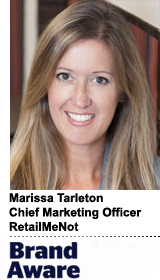 “Brand Aware” explores the data-driven digital ad ecosystem from the marketer’s point of view.
“Brand Aware” explores the data-driven digital ad ecosystem from the marketer’s point of view.
Today’s column is written by Marissa Tarleton, chief marketing officer at RetailMeNot.
Building strong brands is a priority for any company. In the past it was viewed as its own goal, separate from performance marketing. The two are often talked about as two distinct activities, and media-mix allocation is bucketed in brand-vs.-performance distribution.
The landscape has changed, though, and marketers need to prepare for a dovetailing of the two. Brands want growth and differentiation, but that cannot be done with investments in brand or performance alone. Most best practices now suggest that the smartest media approaches are those that accomplish both brand-building and performance benefits cohesively.
Traditionally, performance marketing has been associated primarily with digital channels, and its strength has been strong measurability, particularly to take action within the quarter. What’s not to love? Everyone dropped their focus on brand and moved media in that direction.
It’s not that simple, though. Marketers need to look for the media partners and agencies that think beyond one or two channels. Conversely, brand agencies need to be held accountable for measurable ROI.
I see a few places where marketers can start to get creative.
Performance marketing needs to build brands but in a more personalized way
Marketers should think about their message and content strategies in a more one-to-one way, knowing that they can be targeted to specific audiences. Analytics and automation will create the need for more tools to assess the landscape and audience.
This doesn’t mean that we should remove creative from the process. Creative will be required even more as the content volume ramps up and the need for testing multiplies. It is imperative for in-house brand teams to create a strong tone of voice and a clear creative brief to keep performance and brand marketers cohesive in their goals.
Marketers are also beginning to rethink a fully programmatic advertising program in favor of a more manual approach to buying media. This ensures that their creative matches the context in which it’s served in a brand-safe way. Marketers can ask for more from their agencies to better use performance media for both brand-building and performance.
Brand and creative must understand how to better integrate analytics into their process
Incorporating stronger insights and data into the creative process can help brand teams expand advertising more deeply into digital channels.
Many companies build their brand creative based on the channel. Often, this can cause silos with a larger agency partner that is building out its TV and brand assets, while the remaining digital and print assets are delegated to an in-house design team or other partners. Instead, companies should build out a central, critical message – a key value proposition, message or claim – and create all assets around it.
One highly successful brand-building and performance media vehicle that RetailMeNot has tested is digital radio. Not only is it super-targeted and measurable, it has one of the highest impacts on brand consideration.
No matter what vehicle or channel your team chooses, though, the role of a company’s creative team and brand-agency partners must shift, and they must begin to work cross-functionally around the data available.
Personalization is table stakes
Broad segmentation does not apply anymore; our communication must be one-to-one using mobile-marketing automation tools.
Marketers can now strive for more one-to-one marketing because data and insights allow us to see particular consumers when they are stepping into a certain store and shopping for a particular item. Of course, marketers must take the necessary precautions to gain the trust of their users by allowing consumers to decide which personalization factors they wish to opt in or out of. The goal should be to help customers find what they are searching for, while also removing any and all “creepy” factors of personalization.
However, as data starts to drive more of our media mix, brand and performance can work together to accomplish the goal of delivering the right message to the right person at the right time. And when there is a strong partnership between marketing teams and analytics teams, CMOs can better understand how well their marketing dollars are being spent.
Brand marketers should be well versed in the analytics and data behind creative, while digital marketing leaders must be in sync with brand goals. Both performance marketing teams and brand teams, plus their agency partnerships, are equally important to the success of a business.
However, each must continue to evolve to survive in this era of data, insights, increasing consumer demand for seamless experiences and the need to create content with a centralized approach.
Follow RetailMeNot (@RetailMeNot) and AdExchanger (@adexchanger) on Twitter.
This post was syndicated from Ad Exchanger.


More Stories
Is Tegna Looking to Hub Weather in Its Local Markets?
Stuff Group taps Belinda Francis to lead North Island Markets
Veteran Meteorologist James Spann Voices Support for NOAA and NWS in Anticipation of Trump Cuts